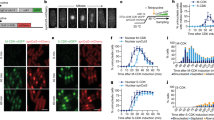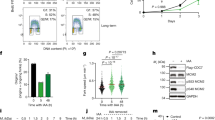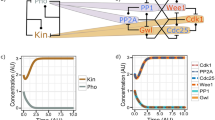Abstract
Cyclin-dependent kinases (CDKs) activate the firing of replication origins during the S phase of the cell cycle. They also block re-initiation of DNA replication within a single cell cycle, by preventing the assembly of prereplicative complexes at origins. We show here that, in budding yeast, CDKs exclude the essential prereplicative-complex component Mcm4 from the nucleus. Although origin firing can be triggered by the B-type cyclins only, both G1-phase and B-type cyclins cause exit of Mcm4 from the nucleus. These results suggest that G1 cyclins may diminish the cell’s capacity to assemble prereplicative complexes before B-type cyclins trigger origin firing during S phase.
This is a preview of subscription content, access via your institution
Access options
Subscribe to this journal
Receive 12 print issues and online access
$209.00 per year
only $17.42 per issue
Buy this article
- Purchase on SpringerLink
- Instant access to full article PDF
Prices may be subject to local taxes which are calculated during checkout









Similar content being viewed by others
References
Bell, S. P. & Stillman, B. Nucleotide dependent recognition of chromosomal origins of DNA replication by a multi-protein complex. Nature 357, 128–134 ( 1992).
Diffley, J. F. X. & Cocker, J. H. Protein-DNA interactions at a yeast replication origin. Nature 357, 169–172 (1992).
Diffley, J. F. X., Cocker, J. H., Dowell, S. J. & Rowley, A. Two steps in the assembly of complexes at yeast replication origins in vivo. Cell 78, 303– 316 (1994).
Santocanale, C. & Diffley, J. F. X. ORC- and Cdc6-dependent complexes at active and inactive chromosomal replication origins in Saccharomyces cerevisiae. EMBO J. 15, 6671–6679 (1996).
Aparicio, O. M., Weinstein, D. M. & Bell, S. P. Components and dynamics of DNA replication complexes in S. cerevisiae: redistribution of MCM complexes and Cdc45p during S phase. Cell 91, 59–69 (1997).
Tanaka, T., Knapp, D. & Nasmyth, K. Loading of an Mcm protein onto DNA-replication origins is regulated by Cdc6p and CDKs. Cell 90, 649–660 (1997).
Cocker, J. H., Piatti, S., Santocanale, C., Nasmyth, K. & Diffley, J. F. X. An essential role for the Cdc6 protein in forming the pre-replicative complexes of budding yeast. Nature 379, 180–182 ( 1996).
Piatti, S., Lengauer, C. & Nasmyth, K. Cdc6 is an unstable protein whose de novo synthesis in G1 is important for the onset of S phase and for preventing a “reductional” anaphase in the budding yeast Saccharomyces cerevisiae. EMBO J. 14, 3788–3799 ( 1995).
Drury, L. S., Perkins, G. & Diffley, J. F. X. The Cdc4/34/53 pathway targets Cdc6p for proteolysis in budding yeast. EMBO J. 16, 5966– 5976 (1997).
Kearsey, S. E. & Labib, K. MCM proteins: evolution, properties, and role in DNA replication. Biochim. Biophys. Acta 1398, 113–136 ( 1998).
Tye, B. K. Mcm proteins in DNA replication. Annu. Rev. Biochem. 68, 649–686 (1999).
Yan, H., Merchant, A. M. & Tye, B.-K. Cell cycle-regulated nuclear localisation of MCM2 and MCM3, which are required for the initiation of DNA synthesis at chromosomal replication origins in yeast. Genes Dev. 7, 2149–2160 (1993).
Donovan, S., Harwood, J., Drury, L. S. & Diffley, J. F. X. Cdc6-dependent loading of Mcm proteins onto pre-replicative chromatin in budding yeast. Proc. Natl Acad. Sci. USA 94, 5611 –5616 (1997).
Liang, C. & Stillman, B. Persistent initiation of DNA replication and chromatin-bound MCM proteins during the cell cycle in cdc6 mutants . Genes Dev. 11, 3375–3386 (1997).
Young, M. R. & Tye, B. K. Mcm2 and Mcm3 are constitutive nuclear proteins that exhibit distinct isoforms and bind chromatin during specific cell cycle stages of Saccharomyces cerevisiae. Mol. Biol. Cell 8, 1587–1601 ( 1997).
Weinreich, M., Liang, C. & Stillman, B. The Cdc6p nucleotide-binding motif is required for loading Mcm proteins onto chromatin. Proc. Natl Acad. Sci. USA 96, 441–446 (1999).
Donaldson, A. D. et al. CLB5-dependent activation of late replication origins in S. cerevisiae. Mol. Cell 2, 173– 183 (1998).
Dahmann, C., Diffley, J. F. X. & Nasmyth, K. A. S-phase-promoting cyclin-dependent kinases prevent re-replication by inhibiting the transition of origins to a pre-replicative state. Curr. Biol. 5, 1257– 1269 (1995).
Detweiler, C. S. & Li, J. J. Ectopic induction of Clb2 in early G1 phase is sufficient to block prereplicative complex formation in Saccharomyces cerevisiae. Proc. Natl Acad. Sci. USA 95, 2384–2389 (1998).
Broek, D., Bartlett, R., Crawford, K. & Nurse, P. Involvement of p34cdc2 in establishing the dependency of S phase on mitosis. Nature 349, 388– 393 (1991).
Hayles, J., Fisher, D., Woollard, A. & Nurse, P. Temporal order of S phase and mitosis in fission yeast is determined by the state of the p34cdc2-mitotic B cyclin complex. Cell 78, 813–822 (1994).
Moreno, S. & Nurse, P. Regulation of progression through the G1 phase of the cell-cycle by the rum1+ gene. Nature 367, 236–242 ( 1994).
Labib, K., Moreno, S. & Nurse, P. Interaction of cdc2 and rum1 regulates Start and S-phase in fission yeast. J. Cell Sci. 108, 3285 –3294 (1995).
Itzhaki, J. E., Gilbert, C. S. & Porter, A. C. Construction by gene targeting in human cells of a ‘‘conditional’’ CDC2 mutant that rereplicates its DNA. Nature Genet. 15, 258– 265 (1997).
Nishitani, H. & Nurse, P. p65cdc18 plays a major role controlling the initiation of DNA replication in fission yeast. Cell 83, 397–405 ( 1995).
Jallepalli, P. V., Brown, G. W., Muzi-Falconi, M., Tien, D. & Kelly, T. J. Regulation of the replication initiator protein p65cdc18 by CDK phosphorylation. Genes Dev. 11, 2767–2779 ( 1997).
Lopez-Girona, A., Mondesert, O., Leatherwood, J. & Russell, P. Negative regulation of cdc18 DNA replication protein by cdc2. Mol. Biol. Cell 9, 63–73 (1998).
Sánchez, M. M., Calzada, J. A. & Bueno, A. Functionally homologous DNA replication genes in fission and budding yeast. J. Cell Sci. 112, 2381 –2390 (1999).
Hennessy, K. M., Clark, C. D. & Botstein, D. Subcellular localization of yeast CDC46 varies with the cell cycle. Genes Dev. 4, 2252– 2263 (1990).
Dalton, S. & Whitbread, L. Cell-cycle-regulated nuclear import and export of Cdc47, a protein essential for initiation of DNA-replication in budding yeast. Proc. Natl Acad. Sci. USA 92, 2514–2518 (1995).
Amon, A., Irniger, S. & Nasmyth, K. Closing the cell cycle circle in yeast: G2 cyclin proteolysis initiated at mitosis persists until the activation of G1 cyclins in the next cycle. Cell 77, 1037–1050 (1994).
Tyers, M. The cyclin-dependent kinase inhibitor p40SIC1 imposes the requirement for Cln G1 cyclin function at Start. Proc. Natl Acad. Sci. USA 93, 7772–7776 ( 1996).
Verma, R., Feldman, R. M. & Deshaies, R. J. SIC1 is ubiquitinated in vitro by a pathway that requires CDC4, CDC34, and cyclin/CDK activities. Mol. Biol. Cell 8, 1427–1437 ( 1997).
Desdouets, C. et al. Evidence for a Cdc6p-independent mitotic resetting event involving DNA polymerase α. EMBO J. 17, 4139 –4146 (1998).
Surana, U. et al. Destruction of the CDC28/CLB mitotic kinase is not required for the metaphase to anaphase transition in budding yeast. EMBO J. 12, 1969–1978 ( 1993).
Piatti, S., Bohm, T., Cocker, J. H., Diffley, J. F. X. & Nasmyth, K. Activation of S-phase promoting CDKs in late G1 defines a ‘‘point of no return’’ after which Cdc6 synthesis cannot promote DNA replication in yeast. Genes Dev. 10, 1516–1531 (1996).
Amon, A., Tyers, M., Futcher, B. & Nasmyth, K. Mechanisms that help the yeast cell cycle clock tick: G2 cyclins transcriptionally activate G2 cyclins and repress G1 cyclins. Cell 74, 993–1007 (1993).
Dohmen, R. J., Wu, P. & Varshavsky, A. Heat-inducible degron: a method for constructing temperature-sensitive mutants. Science 263, 1273– 1276 (1994).
Zwerschke, W., Rottjakob, H.-W. & Küntzel, H. The Saccharomyces cerevisiae CDC6 gene is transcribed at late mitosis and encodes a ATP/GTPase controlling S phase initiation. J. Biol. Chem. 269, 23351– 23356 (1994).
McInerny, C. J., Partridge, J. F., Mikesell, G. E., Creemer, D. P. & Breeden, L. L. A novel Mcm1-dependent element in the SWI4, CLN3, CDC6, and CDC47 promoters activates M/G1-specific transcription . Genes Dev. 11, 1277–1288 (1999).
Blow, J. J. & Laskey, R. A. A role for the nuclear envelope in controlling DNA replication within the cell cycle. Nature 332, 546–548 (1988).
Thommes, P., Kubota, Y., Takisawa, H. & Blow, J. J. The RLF-M component of the replication licensing system forms complexes containing all six MCM/P1 polypeptides. EMBO J. 16, 3312– 3319 (1997).
Hua, X. H., Yan, H. & Newport, J. A role for Cdk2 kinase in negatively regulating DNA replication during S phase of the cell cycle. J. Cell. Biol. 137 , 183–192 (1997).
Sanders Williams, R., Shohet, R. V. & Stillman, B. A human protein related to yeast Cdc6p. Proc. Natl Acad. Sci. USA 94, 142– 147 (1997).
Saha, P. et al. Human CDC6/Cdc18 associates with Orc1 and cyclin-cdk and is selectively eliminated from the nucleus at the onset of S phase. Mol. Cell Biol. 18, 2758–2767 ( 1998).
Jiang, W., Wells, N. J. & Hunter, T. Multistep regulation of DNA regulation by Cdk phosphorylation of HsCdc6. Proc. Natl Acad. Sci. USA 96, 6193–6198 (1999).
Peterson, B. O., Lukas, J., Sorenson, C. S., Bartek, J. & Helin, K. Phosphorylation of mammalian CDC6 by Cyclin A/CDK2 regulates its subcellular localization. EMBO J. 18, 396–410 ( 1999).
Sikorski, R. S. & Hieter, P. A system of shuttle vectors and yeast host strains designed for efficient manipulation of DNA in Saccharomyces cerevisiae. Genetics 122, 19–27 (1989).
Acknowledgements
We thank A. Pidoux for suggestions regarding time-lapse analysis of live cells; I. Adams and J. Kilmartin for suggesting the use of a short linker when tagging proteins with GFP; J.A. Tercero for help in growing cultures; K. Boussett, L. Drury, L. Johnston, G. Perkins and A. Varshavsky for plasmids; K. Nasmyth for strains; our colleagues in the Chromosome Replication laboratory and S.E.K.’s group for helpful discussions; and T. Toda for comments on the manuscript. This work was funded by the Imperial Cancer Research Fund, the Cancer Research Campaign, the Wellcome Foundation, and the EU (contract ERB-MRX-CT970125).
Correspondence and requests for materials should be addressed to J.F.X.D.
Supplementary information is available on Nature Cell Biology’s World-Wide Web site (http://cellbio.nature.com ) or as paper copy from the London editorial office of Nature Cell Biology.
Author information
Authors and Affiliations
Corresponding author
Supplementary information
Rights and permissions
About this article
Cite this article
Labib, K., Diffley, J. & Kearsey, S. G1-phase and B-type cyclins exclude the DNA-replication factor Mcm4 from the nucleus. Nat Cell Biol 1, 415–422 (1999). https://doi.org/10.1038/15649
Received:
Revised:
Accepted:
Published:
Issue Date:
DOI: https://doi.org/10.1038/15649
This article is cited by
-
Checkpoint-dependent RNR induction promotes fork restart after replicative stress
Scientific Reports (2015)
-
Switch on the engine: how the eukaryotic replicative helicase MCM2–7 becomes activated
Chromosoma (2015)
-
A quantitative model of the initiation of DNA replication in Saccharomyces cerevisiae predicts the effects of system perturbations
BMC Systems Biology (2012)
-
The Mitotic Exit Network and Cdc14 phosphatase initiate cytokinesis by counteracting CDK phosphorylations and blocking polarised growth
The EMBO Journal (2012)
-
Regulation of the initiation step of DNA replication by cyclin-dependent kinases
Chromosoma (2010)



